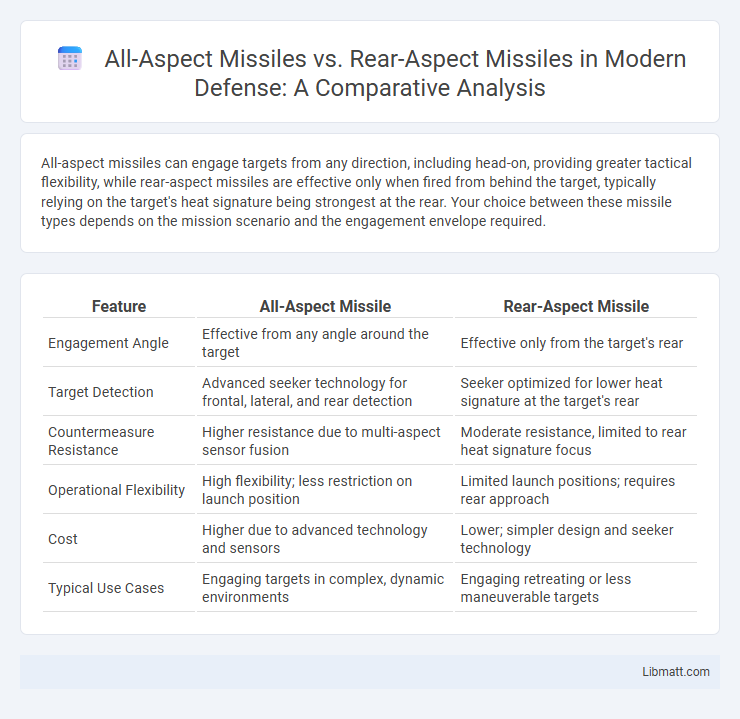All-aspect missiles can engage targets from any direction, including head-on, providing greater tactical flexibility, while rear-aspect missiles are effective only when fired from behind the target, typically relying on the target's heat signature being strongest at the rear. Your choice between these missile types depends on the mission scenario and the engagement envelope required.
Table of Comparison
| Feature | All-Aspect Missile | Rear-Aspect Missile |
|---|---|---|
| Engagement Angle | Effective from any angle around the target | Effective only from the target's rear |
| Target Detection | Advanced seeker technology for frontal, lateral, and rear detection | Seeker optimized for lower heat signature at the target's rear |
| Countermeasure Resistance | Higher resistance due to multi-aspect sensor fusion | Moderate resistance, limited to rear heat signature focus |
| Operational Flexibility | High flexibility; less restriction on launch position | Limited launch positions; requires rear approach |
| Cost | Higher due to advanced technology and sensors | Lower; simpler design and seeker technology |
| Typical Use Cases | Engaging targets in complex, dynamic environments | Engaging retreating or less maneuverable targets |
Introduction to Air-to-Air Missile Guidance
All-aspect missiles utilize advanced infrared or radar seekers capable of detecting and tracking targets from multiple angles, including head-on engagements, which significantly enhances engagement flexibility compared to rear-aspect missiles that can only lock onto the target's exhaust heat signature. Rear-aspect missiles rely predominantly on infrared homing sensors optimized for tail-chase scenarios, limiting their effective engagement envelope and making them less versatile in dynamic air-to-air combat. Modern air-to-air missile guidance systems increasingly prioritize all-aspect capability by integrating imaging infrared (IIR) and active radar homing technologies to improve target acquisition, tracking accuracy, and kill probability against maneuvering adversaries.
What Are All-Aspect Missiles?
All-aspect missiles are advanced air-to-air or surface-to-air missiles capable of detecting and engaging targets from any direction, including head-on, side, or rear aspects. These missiles employ sophisticated sensors such as active radar homing or infrared seekers with wide field-of-view to track enemy aircraft regardless of their orientation. Your defense systems benefit from all-aspect missiles' versatility and improved engagement envelope compared to rear-aspect missiles, which only track targets from behind.
Understanding Rear-Aspect Missiles
Rear-aspect missiles target an aircraft's heat signature from behind, exploiting the higher infrared emissions of jet engines in this region. These missiles require your aircraft to expose its rear to the threat, making evasive maneuvers critical for survival. Understanding the limitations of rear-aspect missiles helps you anticipate attack angles and deploy countermeasures effectively.
Key Differences Between All-Aspect and Rear-Aspect Missiles
All-aspect missiles can engage targets from any direction, including head-on, providing greater tactical flexibility and higher chances of successful interception. Rear-aspect missiles require an enemy aircraft to be targeted from behind, limiting their effectiveness to chasing engagements and reducing engagement options. Your missile defense strategy benefits from all-aspect capabilities by enhancing engagement envelopes and increasing the likelihood of neutralizing fast-moving threats.
Technological Evolution of Missile Seekers
All-aspect missile seekers have evolved to detect targets from any angle, employing advanced imaging infrared and active radar homing technologies that allow engagement even when the target's exhaust is not directly visible. Rear-aspect missile seekers were initially limited to infrared signatures primarily from the target's engine exhaust, restricting engagement angles and requiring precise positioning behind the target. The shift to all-aspect capability reflects significant advancements in sensor sensitivity, signal processing algorithms, and multi-spectral seeker integration, enhancing target acquisition and hit probability across diverse combat scenarios.
Advantages of All-Aspect Missiles
All-aspect missiles offer superior targeting capabilities by engaging enemy aircraft from any direction, including head-on, significantly increasing hit probability. Their advanced infrared and radar seekers enhance detection range and resistance to countermeasures, providing a tactical edge in combat scenarios. You gain greater flexibility and survivability with all-aspect missiles, making them essential for modern aerial warfare.
Limitations of Rear-Aspect Missiles
Rear-aspect missiles are limited by their need to engage targets primarily from behind, reducing their effectiveness in dynamic combat scenarios where threats can approach from multiple directions. These missiles rely on heat signatures from aircraft exhausts, making them less capable against stealth or low-heat emission technologies. Your defense strategy benefits from incorporating all-aspect missiles, which can track and engage targets from any angle, overcoming the directional constraints of rear-aspect systems.
Tactical Implications in Aerial Combat
All-aspect missiles offer significant tactical advantages in aerial combat by enabling engagement of enemy aircraft from any direction, increasing flexibility in offensive and defensive maneuvers. Rear-aspect missiles require a target to be tracked from behind, limiting engagement opportunities and necessitating stealth or positional superiority before launch. The ability of all-aspect missiles to lock on from multiple angles enhances situational awareness and reduces the risk of counterattack, shifting combat dynamics towards more aggressive and unpredictable tactics.
Real-World Examples and Case Studies
All-aspect missiles, such as the AIM-120 AMRAAM, can engage targets from any direction, providing a tactical advantage in diverse combat scenarios, unlike rear-aspect missiles like the early AIM-9 Sidewinder, which require targeting from behind. Real-world case studies include the successful employment of all-aspect missiles during the Gulf War, where they demonstrated superior target acquisition and engagement capabilities compared to rear-aspect missiles constrained by limited attack angles. Your choice of missile technology impacts mission effectiveness by balancing engagement flexibility with weapon system complexity.
Future Trends in Air-to-Air Missile Development
Future trends in air-to-air missile development emphasize enhancing all-aspect engagement capabilities, enabling missiles to detect and strike targets from any direction using advanced multi-spectral seekers and AI-driven target recognition. Rear-aspect missiles, traditionally limited to tail-chase shots, are being improved with longer ranges and higher maneuverability but are gradually overshadowed by all-aspect designs that increase survivability and tactical flexibility in complex combat environments. Integration of network-centric warfare systems and real-time data fusion further augments all-aspect missile effectiveness, making them central to next-generation aerial combat strategies.
All-aspect missile vs Rear-aspect missile Infographic

 libmatt.com
libmatt.com